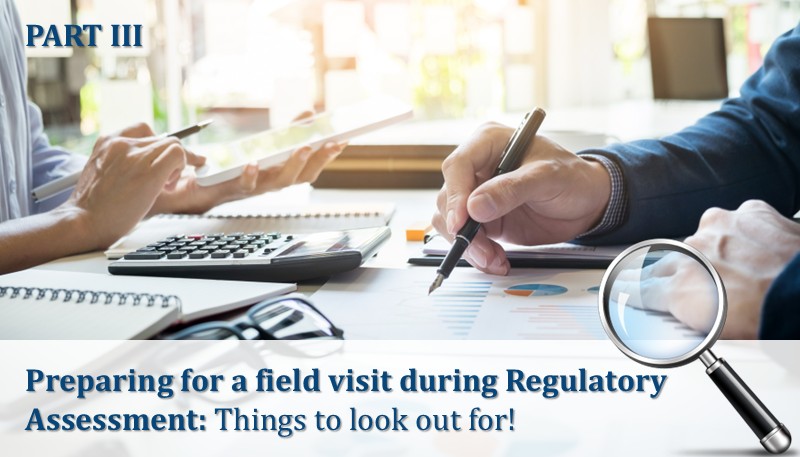Welcome back to our blog series on regulatory assessment experiences. Or, audits, as they are called in common parlance. This four-part series is designed to equip both businesses and auditors with practical techniques to ensure that regulatory assessments go beyond ticking boxes, and actually help organisations strengthen their compliance processes and become more compliant. In the first of this blog series, we explored what it takes for a business to prepare for an assessment. On the second blog we have flipped the lens and examined the same process from an assessor’s point of view. In this, the third blog, we shift our focus to a critical phase of the regulatory assessment journey: the field visit.
Reaching this stage means that several important milestones have already been achieved, from preparing the business for evaluation to ensuring that the assessment team is well-equipped and ready to engage. The field visit is an opportunity to uncover blind spots. A well-planned field visit not only strengthens the assessment process but also enables on-site stakeholders to support the visit smoothly and effectively.
Whether you are visiting a factory, warehouse, construction site, or an office, there are specific things you should always watch out for during a site visit. But before we get into that, it is important to outline a few key preparatory steps we consistently follow at Lexplosion to ensure our field visits are efficient and focused.
Actions ahead of Regulatory field /site visits
- Request Assessment Documents in Advance: Before the scheduled visit, it is critical to obtain key assessment documents. For instance, if you are visiting a factory, having access to the site plan in advance helps the third-party regulatory assessor (“assessor/s”) identify the important zones of the factory and prepare targeted walkthrough sessions.
- Conduct a Preliminary Review of Core Documents: While this might not be a comprehensive document review, reviewing the initial set of documents that have been uploaded by the business, helps shape relevant field visit questions. For example, if crucial documents like the factory license or consent orders are missing or incomplete, this should be flagged early and followed up during the visit itself. We will dig much deeper into what to look out for while reviewing documents as a part of the regulatory audit process in the final blog of this series.
- Prepare a Consolidated Display Compliance Checklist: Since field visits often focus heavily on display-related obligations, it is useful to compile a list of display requirements based on the in-scope compliances beforehand. Having this checklist handy during the walkthrough significantly reduces the chances of overlooking key display requirements.
Site visit essentials: What to observe?
Attention to detail is key. Especially during the site visit stage of a regulatory assessment. In fact, it is one of the most important aspects to focus on throughout the entire assessment process. The goal of a site-visit is not to catch anyone off guard but to understand how things work on the ground and suggest meaningful improvements. While site visits may include display checks, but they go beyond that. They also involve assessing worker safety practices, working conditions, and environmental health and safety measures.
Based on our regulatory assessment experience at sites, we focused on understanding the root causes behind compliance breaches instead of simply questioning why a particular requirement was not met. In this blog, we will share real-life scenarios to help you relate to your own processes. Please note that the examples are from a manufacturing unit perspective, and experiences may vary across different types of business units.
SAFETY
When it is a factory, SAFETY is at the CORE and any safety-related gap is a major red flag. Now, safety covers a lot of things. At a manufacturing unit involving hazardous process, the first and the most important sign that comes to sight at various places are “NO-SMOKING” boards. In spite of that, seeing cigarette butts and tobacco packets lying around the factory premises can signal a serious non-compliance. What is even more concerning is when there is no designated person responsible for handling complaints related to violations of tobacco laws. According to the Cigarettes and Other Tobacco Products (Prohibition of Advertisement and Regulation of Trade and Commerce, Production, Supply and Distribution) Act, 2003, it is mandatory to prominently display the name of the officer responsible for receiving such complaints.
Beyond smoking related concerns, another important aspect of a factory visit is the presence of “Danger” notices; “Caution” signboards”; and, areas demarcated as “Hazardous Areas”. For example, areas with high voltage, hazardous substances, or gas cylinders must be clearly marked with signs such as “Danger,” “Caution,” or “Hazardous Area.” The absence of these signs poses a serious risk not just to visitors, but also to workers operating in these areas daily. Other critical safety lapses include lack of fire-fighting equipment near petroleum storage areas, which can be particularly risky given the flammable nature of petroleum; poorly marked emergency exits; inadequate use of Personal Protective Equipment (PPE) by people working in production processes; and no display of maximum working load on ladders.
WORKING CONDITIONS AND FACILITIES
A factory’s production process depends entirely on the workers involved. To ensure smooth and uninterrupted operations, it is essential to provide workers with proper working conditions and facilities. This starts with basic welfare measures such as a well-ventilated and adequately lit production floor. These are not just comfort-related provisions but are also closely tied to workplace safety standards that workers must be aware of and protected by.
During assessment walkthroughs, certain observations can raise red flags about working conditions. For example:
- Entering a high-noise area where workers are not provided with earplugs
- Stepping in to a production floor that has poor lighting or insufficient ventilation
- Workers using lifts and belts which lack periodic testing
Such conditions indicate potential non-compliance and pose risks to worker health and safety.
In factories that involve hazardous processes and employ more than 50 workers, having an Occupational Health Centre (OHC) in the premises is a regulatory requirement and more importantly, a critical part of worker welfare. Not having an OHC within the factory premises goes against the intent of the compliance requirement. Even when an OHC is present, issues such as poor hygiene, lack of sanitation, or the centre being located outside the factory grounds raise serious concerns. An OHC should be easily accessible, well-maintained, and fully equipped to support the health and safety of workers, especially in high-risk environments.
ENVIRONMENT WASTE MANAGEMENT
An important part of any regulatory assessment is evaluating how well a factory manages its environmental responsibilities and waste disposal processes. As mentioned earlier in this blog in the sub-section relating to Preliminary Review of Core Documents, one key document is the Consent to Operate. This document lays down the permitted quantities of emissions / discharges during the manufacturing process and also prescribes the disposal mechanism of waste generated, among other conditions. While reviewing documents like the Environmental Statement can give insight into compliance on paper, the real test lies on the practical implementation during a site visit. This is where actual practices must align with documented commitments. In our experience, the most common issues in this area relate to improper segregation and disposal of waste. Key observations include:
- Poorly segregated solid waste, e-waste, plastic, and liquid waste stored together in inappropriate or mixed areas
- Hazardous waste not stored in clearly designated, secure areas
- Bio-medical waste from the factory’s Occupational Health Centre (OHC) not disposed of through proper channels
Even though the OHC is typically limited to first-aid services, it still generates bio-medical waste such as expired medicines or blood-soiled cotton swabs which must be disposed of correctly. This includes using colour-coded bins for segregation and ensuring disposal through authorized channels. It is also important to note that, under the Bio-medical Waste Management Rules, 2016, the responsibility to obtain authorization for handling such waste lies with the handler.
Proper environmental and waste management is not just a compliance formality but it also reflects a factory’s commitment to sustainable and responsible operations.
Conclusion: Where Compliance Meets Reality
The field visit is a pivotal stage in the regulatory assessment process; one that moves beyond paperwork to reveal how compliance is practiced in real-world operations. Whether it is identifying safety lapses, assessing working conditions, or reviewing environmental and waste management practices, these on-site observations help uncover issues that may otherwise go unnoticed. By focusing on practical implementation, field visits offer a valuable opportunity to drive meaningful change, strengthen internal controls and support continuous improvement. Ultimately, the goal is not just to comply with regulations, but to build safer, healthier, and more responsible workplaces.
What makes this stage so critical is its potential to uncover systemic issues and prompt immediate course correction. Site visits are not about fault-finding for the sake of it, they are a chance to strengthen operational discipline, reinforce compliance culture, and protect the very people who run the business day in and day out.
By focusing on site-level realities, from safety practices and worker welfare to waste handling, auditors can help businesses bridge the gap between policy and practice. And in doing so, they contribute to building workplaces that are not just legally compliant, but ethically and operationally sound.
Field Visit Tips: Practical Wisdom from the Ground
Before, we conclude, we wanted to share some practical reminders for assessors preparing for factory or warehouse visits, based on our countless on-site experiences:
- Adjust Expectations About Accommodation: If the factory is in a remote location, do not expect luxury. Guest houses organised by clients may be basic. Carry essentials, including bedsheets or mosquito repellent, if needed.
- Hydrate and Rest Well: Field visits are physically demanding, especially in non-air-conditioned environments. Carry water, take breaks when needed, and do not ignore signs of fatigue.
- Wear the Right Gear: Be prepared to walk long distances, often through uneven terrain, wearing industrial boots, hard hats, and other PPE. Comfort and safety should not be compromised.
- Take Notes Constantly: Do not trust your memory. Carry a pocket notebook or use your mobile device (if permitted) to jot down real-time observations. These notes will be critical for your final report.
- Respect Site Protocols: Always follow the site’s safety instructions, sign in at security, attend safety briefings, and do not enter restricted areas without clearance.
- Watch Without Interfering: Observe how things operate during regular business hours without disrupting workflows. Your job is to assess, not to direct operations.
- Build Rapport with Supervisors and Workers: Many insights come from casual conversations – listen actively, ask non-threatening questions, and remain respectful, especially when something appears non-compliant.
Stay tuned for the final part of this series, where we will dive deeper into how to review and analyse core compliance documents for a well-rounded regulatory assessment.
Lexplosion Solutions has been helping businesses across India get audit-ready through structured, on-ground regulatory assessments. Our team works closely with compliance, legal, and site teams to identify gaps, verify documentation, and ensure your processes reflect the compliance you report.
If you’re preparing for regulatory assessments, let’s talk. Get in touch
Written by: Baishali Chakraborty
Disclaimer
This content is intended for informational purposes only and does not constitute a legal opinion. Despite our efforts to maintain accuracy, we do not make representations, warranties or undertakings regarding the quality, completeness or reliability of the content. Readers are encouraged to seek legal counsel prior to acting upon any of the information provided herein. This content, including the design, text, graphics, their selection and arrangement, is Copyright 2024, Lexplosion Solutions Private Limited or its licensors. ALL RIGHTS RESERVED, and all moral rights are asserted and reserved.
For any clarifications, please reach out to us at 91-33-40618083 or inquiries@lexplosion.in. Refer to our privacy policy by clicking here.





